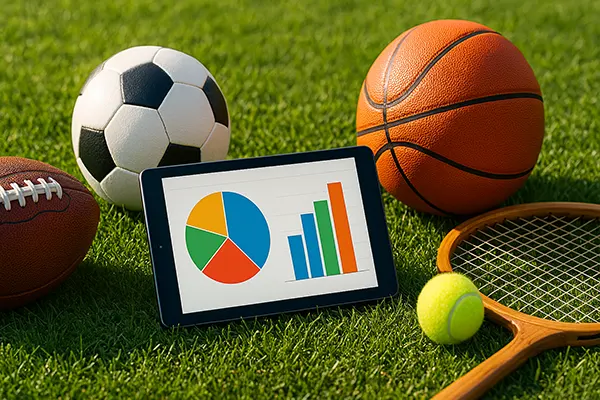How to Use Statistics to Predict Sports Outcomes: Key Metric Analysis

In the world of sports betting, accurate predictions are built not on luck, but on solid data. With the increasing availability of sports statistics, enthusiasts and professionals alike are now turning to analytical models and performance metrics to forecast game results more reliably. By diving into team form, player statistics, and contextual game factors, bettors gain the tools to make smarter decisions based on real insights.
Understanding the Role of Sports Statistics in Predictions
Statistics in sports go far beyond scores and standings. They encapsulate a wide range of factors, from possession rates and shot accuracy to defensive records and historical matchups. These numbers form the foundation of predictive analysis, allowing for nuanced forecasts that account for performance trends and anomalies.
One of the key advantages of using statistics is their objectivity. Unlike intuition or bias, numbers reveal patterns and consistencies that can be tracked over time. For example, a football team with a consistently high number of shots on target per game may have a better chance of scoring, even if they lost their previous match. Such insights help paint a clearer picture of what might happen next.
Moreover, bookmakers themselves use statistical models to set odds. Understanding the same datasets they rely on allows punters to spot value bets — situations where the odds underestimate the real chance of a specific outcome. This turns analysis into opportunity, particularly when applied consistently.
Common Metrics Used in Predictive Sports Analysis
There are several core metrics that analysts often prioritise when predicting outcomes. In football, for instance, Expected Goals (xG) has become a widely accepted metric. It estimates how many goals a team should score based on shot quality, location, and context. A team consistently outperforming or underperforming their xG may be heading for regression or a breakthrough, respectively.
Other relevant indicators include team possession percentages, pass accuracy, and defensive actions per game. These stats offer insight into a team’s playing style and tactical efficiency, helping to predict how they might perform against different types of opposition.
For sports like basketball or tennis, metrics like Player Efficiency Rating (PER) or First Serve Percentage play a crucial role. By comparing player statistics head-to-head, one can often anticipate momentum shifts or likely scoring trends with reasonable confidence.
Integrating Contextual Factors into Statistical Models
While raw data is critical, context often determines how statistics should be interpreted. For example, a football team’s performance at home may differ significantly from their away games due to fan support or pitch familiarity. Similarly, player injuries or weather conditions can dramatically influence outcomes that statistics alone may not predict.
Contextual awareness also includes understanding match significance. A low-stakes friendly game will likely involve squad rotation and experimentation, making statistical projections less reliable. In contrast, tournament knockouts or league deciders typically see teams fielding their strongest line-ups and employing tighter tactics.
Modelling software or spreadsheets should always be supplemented with up-to-date information. Including contextual factors such as lineup confirmations, motivation levels, and schedule congestion greatly improves the robustness of a prediction.
Advanced Modelling Techniques for Forecasting
Data scientists and seasoned analysts often employ machine learning models to refine predictions. These models train on historical datasets to identify relationships between variables that human observers might miss. For example, a regression model might weigh various inputs — such as team form, goal differential, and fixture timing — to generate win probabilities for upcoming matches.
Popular tools like Python, R, or Excel can be used to build such models, often relying on logistic regression or decision trees. These methods classify match outcomes into probable scenarios and update dynamically as new data arrives. This adaptability makes them more precise over time.
Even simpler models — like weighted moving averages — can deliver strong results when well-calibrated. By placing more emphasis on recent games while still factoring in season-long trends, bettors can react faster to emerging shifts in team performance and adjust their strategies accordingly.

The Impact of Real-Time Data and Live Betting
In recent years, the explosion of live data has changed how bettors engage with sports. Live betting markets now offer odds that fluctuate in real time based on in-game statistics. This creates opportunities for bettors who can quickly interpret shifting metrics like possession changes, cards, or substitutions.
Real-time xG updates, heatmaps, and momentum graphs can offer clues about which team is gaining the upper hand. Watching these patterns unfold and correlating them with pre-game expectations helps traders make more accurate live predictions and take advantage of odds adjustments before they stabilise.
Importantly, speed and access are vital. Using apps or platforms that offer instantaneous data feeds — coupled with personal models or alerts — gives bettors a technological edge in fast-paced betting environments. Precision, not emotion, becomes the key to long-term success in live prediction.
Ethical Considerations and Responsible Betting
While statistical tools enhance the ability to predict outcomes, responsible gambling practices must always come first. It is essential to treat betting as a strategic activity rather than a guaranteed path to profit. No model, however advanced, can eliminate uncertainty in sports.
Establishing a clear bankroll, setting limits, and avoiding chasing losses are basic but crucial principles. Even the most accurate forecast can be undone by a single red card or weather change. Understanding and accepting these variables encourages sustainable engagement with sports betting.
Furthermore, transparency in modelling — acknowledging assumptions and limitations — builds trust among users or collaborators. Shared learning and community discussions around statistical methods can help reduce risky behaviours and promote healthier betting habits among sports fans.




